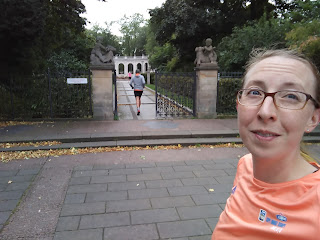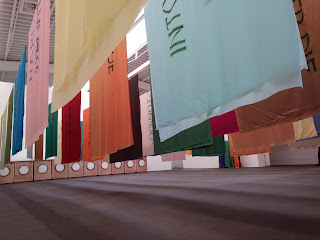I decided to go for a little 3-4 mile jaunt around a local park, the Volkspark Friedrichshain. The entrance was grandiose:
 |
| "Yep, just a little run in a palatial garden..." |
On the run, I saw people walking their dogs (which always makes you feel like you're really hanging out with the locals), lots of other runners, a bird sanctuary, soccer parks, hiking trails, statues (apparent Soviet relics), and lots more. It is obviously a well-loved park!
I think it was at this point in the trip that I also started smearing Nutella on the marbled Bundt cake in the breakfast buffet. Went a little European there...
 To start the day, my travel book recommended that we "ponder the futility of war" at the Kaiser Wilhelm Memorial Church. It was not rebuilt after WWII as a reminder of the carnage, destruction, and sadness that remained after the fighting. You can see the open tower where it was bombed. (More awkward German history...)
To start the day, my travel book recommended that we "ponder the futility of war" at the Kaiser Wilhelm Memorial Church. It was not rebuilt after WWII as a reminder of the carnage, destruction, and sadness that remained after the fighting. You can see the open tower where it was bombed. (More awkward German history...)At this point, we were feeling fairly confident in the Berlin S-Bahn and U-Bahn systems, and we headed out to Schloss Charlottenburg with no problem.
The beautiful baroque palace, full of white and gold and pastels, was commissioned by some German nobles and eventually became one of the homes of Fredrick the Great. It's closer to the Berlin city center than his other Berlin home, Sanssouci (which we'll visit tomorrow), although back in the day I'm sure it was quite a journey on horseback.
 The gardens and grounds were beautiful, definitely worth a walk. The tour of the castle was worth the trip, too. Of course, the castle was bombed - like everything else in Berlin - but they have reconstructed the rooms as well as possible.
The gardens and grounds were beautiful, definitely worth a walk. The tour of the castle was worth the trip, too. Of course, the castle was bombed - like everything else in Berlin - but they have reconstructed the rooms as well as possible. We also got to see some of Fredrick's silver service; it wasn't as extensive as the collection in Vienna's Hofburg, but if I remember correctly, this is where I learned that Fredrick would melt down his silver collection to pay for his wars, then he'd have it reconstructed after the wars were over.
The New Wing was constructed at Frederick's direction and contains some truly spectacular gilded rooms. You could almost hear the harpsichord and flute!

After we'd had our fill of Fredrick's baroque wonderment, we took a friend's recommendation to visit the Hamburger Bahnhof modern art museum.
Like the Musée d'Orsay, the museum is constructed in an old train station. I love modern and contemporary art, and this museum boasted some beautiful and thought-provoking exhibits.
I couldn't even tell you about all of the exhibits we saw. One room had an infinity mirror display, one room had rocks on the floor with projected images of water flowing over them; it was just a really visually stunning museum. And of course, because it's German contemporary art, some of it was rather bleak, including a black cross-shaped room within a room by Bruce Naumann entitled, "Room with My Soul Left Out, Room That Does Not Care." Wowza.
 I'm not sure why, but all over the museum were these red balloons that were on motors to rise and fall on a string.
I'm not sure why, but all over the museum were these red balloons that were on motors to rise and fall on a string. They probably would have creeped me out anyway, but especially so because the remake of the movie "It" was about to be released in American theaters. You'd turn a corner and BAM, red balloon. Pennywise would approve.
After the mind-expanding experience at the art museum, we headed over to the Turkish area of Berlin (Kreuzberg) for some hedonistic food pleasure.
Dave is a big fan of Döner kebabs, and my coworker had given me an article of the best spots in Berlin. We visited the granddaddy of them all, Hasir, where we got kebab platters and delicious beer. It was so good not to feel any guilt over stuffing my face because of how much we walked around on the trip.
I found a yarn store in the Turkish area, then we visited the Jewish Museum for, yes, more awkward German history.
The building itself is stunning - it's an angular precipice with swaths of empty lines that seem to be tearing the building apart. We later read that the empty spaces represent the murdered Jews of Germany (or those that emigrated to avoid the oppression).
The history in the museum was so interesting and new to me, but the museum building itself was the most impressionistic experience.
You start by choosing three paths - emigration, annihilation, or life forward. The museum shows you what happened to the Jews that took each of these paths in the years before the Holocaust. Obviously, it was a very emotional and moving experience.
After that, you had to meander around through the exhibits, seeing the missing sections of humanity that should be filled by generations of Jews that died in the Holocaust or earlier pogroms. We stayed in the museum almost to closing time; it was so full, like the Deutsches Historisches Museum, that you could spend a whole day and not really take it all in.
We had reservations at a Turkish restaurant, Defne, where I had delicious spinach manti and Dave had stuffed eggplant. If anyone can rival Indian cuisine for miraculous transformations of vegetables, it's the Turks.
In the area, there was a bar I kind of wanted to visit, but we had a little trouble finding it because the guidebook actually had it switched with another bar on the map. At any rate, we eventually stopped at Otto Rink for a flight of German wines!
We had whites and reds, none of which we had tried before. The pourer was a very nice German-Hungarian Berliner who told us about a great brewery to try on our last day. Yay for networking about booze!





No comments:
Post a Comment